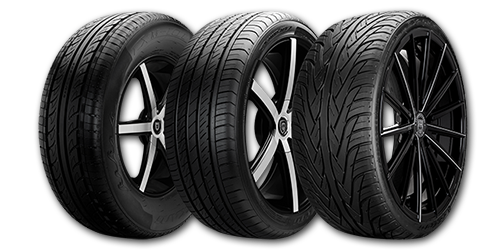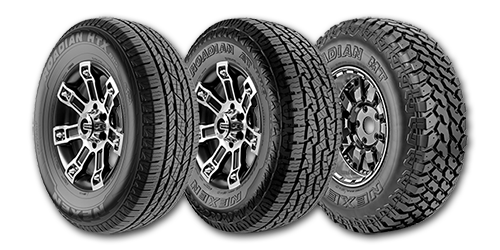Types of Tires - Discounted Wheel Warehouse
Tires come in a variety of categories to meet a broad range of vehicles and driving needs. Tires are largely classified by their size, based on the type of vehicle they are intended for. These size-based tire categories can be further divided by the tire's intended purpose. This page will identify the characteristics of common tire categories to help you find the best tire for you.
Passenger Tires
Passenger tires are average-sized tires designed for personal vehicles that transport people, such as coupes, sedans, hatchbacks, station wagons, and crossovers. They also see use on compact SUVs, minivans, and small pickup trucks. Since they are intended for transporting people, passenger tires are typically designed with stable handling, fuel economy, and passenger comfort in mind. However, their flexible sidewalls are not ideal for carrying heavy loads or driving on offroad terrain.
A passenger tire may be P-metric, identified by the letter "P" at the start of the tire's size rating; or Euro-metric, which has no letter at the start of the size rating. Passenger tires may also be referred to as PCR, short for Passenger Car Radial. Passenger tires are often categorized as "touring" or "performance" tires, based on the driving style they are intended for.
Touring Tires
Touring passenger tires are designed for an comfortable ride at average driving speeds, and emphasize ride quality over handling response. They are optimized for reduced road noise, smooth ride stability, and long treadlife. Touring tires tend to have taller sidewalls to provide more cushioning on the road, resulting in a higher sidewall aspect ratio.
Typically, touring tires overlap with all-season tires, which offer moderate levels of dry, wet, and snow traction, but do not excel in any condition. They tend to have symmetrical tread patterns for ease of installation and rotation. Touring passenger tires tend to be more affordable and longer-lasting than performance tires, making them ideal for day-to-day commuting. Most passenger tires today are touring tires.
Performance Tires
Performance passenger tires are designed with high-speed driving capabilities, and typically emphasize responsive handling over ride quality. They are designed to respond quickly to steering or braking input. Performance tires usually have lower sidewalls and wider treads in order to provide more traction and cornering grip at the cost of ride comfort, resulting in a much lower sidewall aspect ratio.
Typically, performance tires overlap with summer tires, which offer excellent wet and dry handling, but lack snow capabilities. Some performance tires today are designed with all-season utility, sacrificing some wet and dry handling in exchange for a small amount of snow traction. Performance tires may have directional treads for high-speed hydroplaning resistance and responsive steering, while others have asymmetrical treads that balance wet handling with cornering power.
Traditionally, tires could be identified as performance tires based on their speed rating. H-speed tires (approved for speeds up to 130 mph) were considered High Performance tires, while V-speed tires (approved for speeds up to 149 mph) were considered Ultra-High Performance tires. Today, some dedicated performance tires may see speed ratings as high as Y (approved for speeds up to 186 mph).
Grand Touring Tires
Grand touring tires are high-end passenger tires that combine traits of touring and performance tires. They are designed for more responsive handling and higher speed tolerances than a usual touring tire, while still providing a smooth, comfortable ride.
Like touring tires, grand touring tires tend to be all-season tires with a balance of dry, wet, and snow handling. They tend to have asymmetrical tread patterns with wide grooves on the inside treads for traction on wet roads and light snow, while large outer tread blocks provide more cornering stability on dry roads.
Light Truck Tires
Light truck tires are large tires designed for vehicles that typically transport cargo, such as heavy-duty pickup trucks, small box trucks, 4x4s, full-size vans, RVs, and SUVs. Trucking vehicles that weigh 8,500 pounds or less and have a load capacity of 4,000 or less are considered light trucks. LT tires have thick, rigid sidewalls, durable tread compounds, and reinforced internal construction, sacrificing ride comfort for durability and high load capacity. Due to their sturdy, heavy construction, they tend to be less fuel-efficient and demonstrate slower handling response than passenger tires.
A light truck tire is classified as LT-Metric under U.S. tire standards, identified by the letters "LT" at the start of its size rating. Unlike passenger tires, which are almost exclusively for street use, light truck tires are often categorized by the type of terrain they are designed for driving on.
You may also see SUV tires that are listed in a separate category from light truck tires. SUV tires are designed with similar functions to LT-metric tires but are actually P-metric or Euro-metric. They are designed for use on light-duty pickups, crossovers, and SUVs.
Highway Tires
Highway-terrain tires are designed for on-road driving, such as vans or pickup trucks transporting cargo. They can be regarded as the truck equivalent of a touring passenger tire. They tend to emphasize ride stability and long tread life, ideal for regular distance driving. These tires often feature a "rib" pattern of flat, symmetrical tread blocks that stabilizes straight-line driving while helping to dissipate road noise.
Compared to other truck tires, highway tires provide a relatively quiet, comfortable ride, making them desirable for passenger vans and SUVs. Highway truck tires are often all-season, allowing them to remain in service in wet, dry, or snowy conditions. They usually feature wide longitudinal grooves for water evacuation and high slip resistance on wet roads, as well as lateral grooves for grip on light snow. In addition to asphalt pavement, highway tires may handle well on dirt or gravel roads, though they are not suited for offroad terrain.
Mud Tires
Mud-terrain tires are designed for extreme off-road driving. They have aggressive tread patterns with sturdy sidewalls and large tread blocks that provide extreme levels of grip on challenging terrain such as rocks. Their deep voids and aggressive shoulder lugs help to dig securely into loose dirt, soft mud, or deep snow. These tires feature durable tread compounds that resist abrasive road hazards such as sand or gravel. Mud tires have large tread voids to easily release mud and debris, sometimes with thin "stone ejector" bars to prevent from rocks and other hard debris from lodging in the treads.
Though they excel on harsh terrain, mud-terrain tires are not ideal for on-road driving. Due to their aggressive tread designs, mud tires generate lots of noise and rolling resistance on paved roads, which hurts fuel efficiency and wears down the treads faster. Unlike street-oriented tires, their tread patterns are not optimized for water evacuation, making them highly susceptible to hydroplaning on wet, slushy, or icy roads. Additionally, not all mud tires are designed for snow traction, and may be unsuitable for winter conditions depending on the rubber compounds and tread patterns.
All-Terrain Tires
All-terrain tires are designed to handle both on-road and off-road driving. Their treads are more aggressive than the square-like tread blocks on highway tires, but less aggressive than mud-terrain treads. This allows all-terrain tires to grip a variety of rugged terrains such as dirt, gravel, sand, or snow, while providing smoother street handling than a mud tire. All-terrain tires are louder than highway tires, but quieter than mud tires. These versatile tires tend to incorporate tread compounds that exhibit decent abrasion resistance while remaining flexible in colder temperatures.
For even greater versatility, all-terrain tires are also usually all-season tires that perform well throughout the year. Their treads are optimized for water evacuation and hydroplane resistance, and also feature sipes for snow traction, so they handle well on wet, slippery roads. Due to their on-road capabilities, all-terrain tires tend to be more practical for the average truck or Jeep driver than dedicated mud-terrain tires.
Other Types of Tires
Competition Tires
Competition tires are designed for use in racing applications. Sometimes called racing slicks, these tires are drastically different from ordinary street tires due to their smooth treads. They have few grooves, if any, in order to maximize tread surface area and put as much rubber in contact with the road. Since competition tires are used in controlled conditions, they are engineered for absolute dry performance. However, competition tires are generally unsuitable for street use or wet conditions, as smooth tread areas make them extremely susceptible to hydroplaning. They also use extremely soft, flexible compounds to improve road adhesion, but wear extremely quickly.
Trailer Tires
Special Trailer tires are designed for use on towed vehicles, such as camper trailers, boat trailers, and cargo trailers. They tend to have even stronger sidewalls and higher load ratings than light truck tires. However, trailer tires sacrifice handling response in exchange for this extreme durability, and should not be used on cars or light trucks. Trailer tires can be identified by the the letters "ST" at the start of their tire size rating.
Medium Truck Tires
Medium truck tires are designed for use on large vehicles such as buses or semi-trailer trucks. Unlike passenger or light truck tires, medium truck tires are designed with specific commercial applications and types of service in mind, such as regional, line haul, or mixed service. The axles on a semi-trailer truck serve slightly different functions during driving, so the ideal characteristics for a truck tire depend on its axle position: steer, drive, or trailer. There are also "all-position" tires that can be used on any axle.



